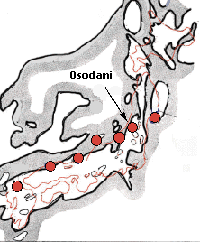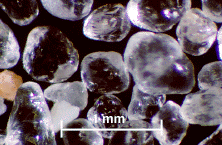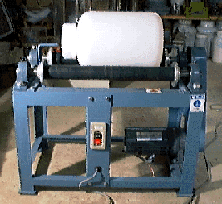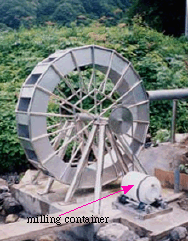 Fig1 Map
of Osodani
Fig1 Map
of Osodani Fig.2
Microscopic Photograph of sand
Fig.2
Microscopic Photograph of sandWhat is Osodani-sandHRed circles show the typical singing sand beaches in Japan. Singing beach in Japan are on a line,which proposed previous Japanese researcher for singing sand.
 Fig1 Map
of Osodani
Fig1 Map
of Osodani Fig.2
Microscopic Photograph of sand
Fig.2
Microscopic Photograph of sandOn the line, we found singing sand in a clay like soil. Osodani(Yamagata Pref. in Japan) is located in the inland area. Fig.1 A geological map of Japan in the Pliocene epoch. Fig.2 shows Osodani sand
In the Pliocene epoch, here was a beach of Japan-sea. The soil include in clay is 99.8 % silica particles. Now the sand are used to a raw material for glass industry. How to recover the singing sand in the clay like soil?
 Fig.3 Motion
of sea water on a beach
Fig.3 Motion
of sea water on a beach
Most strong washing action on a beach is in the surf zone: By the strong eddy motion at the surf zone, the sand particles are rubbed each other. The speed of rubbing is same as the speed (about 0.5 m/sec) of eddy flow in the sea water.
 Fig.4 The washing
machine of sand with electric power.
Fig.4 The washing
machine of sand with electric power.
We realize above motion by using a machine that rotates the clay like soil
in a bottle with water: The diameter of the bottle is 22 cm, rotation speed
is 60 r.p.m., circumference speed is 2488 m/hr. If the rotator-washer runs continuously
for 1000 hours, then the total geffective travel displacementh or moving length
of sand would be approximately 2488 km. The effective travel distance experienced
by the sand immersed in water would be equal to 6.78 mal of the River Shinano,
longest in Japan, 367 km ( Mississippi 3780 km). Such continuous and gentle
rubbing of silicon produces amorphous silica, which is soluble in water. After
about 200 hours of washing and rotating, if the water is changed at regular
interval, the turbidity of washed water change from dirty to milk-white, and
show fluorescence. If we continue the washing and rotating for about 1000 hours,
the sand developes acoustic properties like in the dry state. If we continue
the washing and rotating for about 2000 hours, the sand can produce sound in
water.
 For save energy,we use
a water mill in IIde town.
For save energy,we use
a water mill in IIde town.
Reference:
1. Hashimoto,M.:Proc.Jap.Nat.Cong.App.Mech.,1951,p.361
2. Hashimoto,M.:Chigaku kenkyu(Japanese),Vol.19.No.2,39-45(1968)
3. Miwa,s.,Hidaka,J.,Shimosaka,A.:Kona(Powder Sience and Techinology in Japan),No.1,64-72(1983)